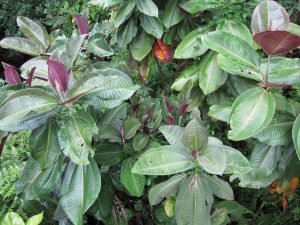THE TARGET: Miconia (Miconia calvescens)
- Miconia is nicknamed the green cancer of the Pacific. Listed as a Noxious Weed in Hawaiʻi by the Hawaiʻi Department of Agriculture and one of the top threats to Hawaiʻi’s watersheds and forest ecosystems., the fast-growing tree in the melastome family invades areas from agricultural landscapes to forests by forming dense stands and shading out other native forest trees with its large leaves. Its uncontrolled growth can overwhelm highly diverse native wet forest ecosystems that are home to critically endangered species and essential as sources of fresh water. Each plant can produce approximately ten million seeds per year, which may remain viable for more than 20 years.
- Distribution: Large infestations exist on Hawaiʻi Island and Maui. Populations are also found on Kauaʻi and Oʻahu. Miconia calvescens is native to Central and South America.
THE CANDIDATE: Euselasia chrysippe
- Euselasia chrysippe is a small butterfly whose caterpillars feed externally on leaves of several species of Miconia. Larvae hatch from large egg masses and continue to molt and move in unison to feeding sites, helping to optimize foraging and deter enemies.
- Native range: Known to occur from southeastern Mexico to northern Columbia.
-
Host testing results: Euselasia chrysippe displayed a high degree of specificity through host range field assessments and was tested in quarantine containment in Hawaiʻi under a series of no-choice and choice tests on 73 plant species from Hawaiʻi and Costa Rica. Results indicate that it does not have the capacity to impact native or economic plants in Hawaiʻi, and its host range is limited to M. calvescens and closely related weeds within the melastome family. Melastomes in Hawaiʻi include miconia, clidemia (Clidemia hirta) and other invasive alien species, but no native species.
Timeline of project progress:
- Final Environmental Assessment — Published in the State of Hawaiʻi Environmental Review Program (ERP) The Environmental Notice on September 23, 2022.
- Awaiting permits from Hawaiʻi Department of Agriculture & import into Hawaiʻi prior to release.
Further Information:
- More information on the host specificity, biology, and testing of the biocontrol agent, Euselasia chrysippe: Euselasia chrysippe as a potential biocontrol for Miconia calvescens in Hawai’i
- Information on Miconia as an invasive species in Hawaii, including island-specific distribution & management: Miconia Invasive Species Profile
